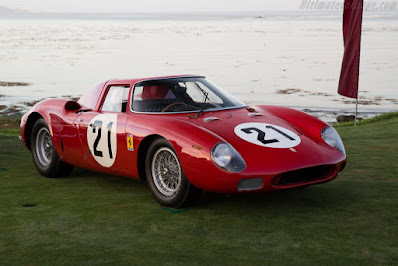Lesser KNOWN After the war, the prancing horse logoed racing cars were known to have always dominated various prestigious racing events in the world. Especially with the launch of the Ferrari 250 GT LWB (Long Wheel Base) in 1954, and the Ferrari domination continued at the end of 1959 by the launching 250 GT SWB (Short Wheel Base) variant. Unfortunately, the Ferrari's domination was recede slowly in 1962 when the 250 GTO varian been born.
 |
| 1963 Ferrari 250 LM with chassis number of 5893 sat on display at the 2015 Pebble Beach Concours d'Elegance. (Picture from: http://bit.ly/3rLbhp0) |
Times are changing, especially with the introduction of mid-mounted engines in the 1950s which significantly changed the outlook of the sport and made many of the previously dominating racing cars obsolete, including the Ferrari 250 GT and 250 GTO.
Again, the Maranello-based car manufacturer seems late to anticipate and respond these technical innovations, just look at they were overtaken by Maserati, its arch-rival whose first built the first and successful mid-engined sports car called the Maserati Tipo 63 powered by a V6 engine in 1961.
 |
| 1963 Ferrari 250 LM with chassis number of 5893 sat on display at the 2015 Pebble Beach Concours d'Elegance. (Picture from: http://bit.ly/3rLbhp0) |
Instead, the first mid-engined car made by the prancing horse logoed auto manufacturer was the Ferrari 156, a F1 racing car which successfully won the 1961 F1 Championship event in both the driver and constructor categories. By the determination and ambition to reclaim the old domination once won through the 250 GT, Ferrari finally decided to build a completely new car called Ferrari 250 LM and designed by Pininfarina.
 |
| 1963 Ferrari 250 LM with chassis number of 5893 sat on display at the 2015 Pebble Beach Concours d'Elegance. (Picture from: http://bit.ly/3rLbhp0) |
The Ferrari 250 LM was first launched to the public at the 1963 Paris Auto Show (Paris Auto Salon), and soon the production version was built by the Maranello-based car manufacturer in 1964. There is a difference between the 250 LM car show version and the production version, namely the engine displacement.
 |
| 1963 Ferrari 250 LM with chassis number of 5893 sat on display at the 2015 Pebble Beach Concours d'Elegance. (Picture from: http://bit.ly/3rLbhp0) |
In the 250 LM show car version still used the GTO derived 3 litre engine, therefore it still deserves to be called 250 LM when referring to the name. Meanwhile, the production version uses the a bored 3.3 liter engine version. When referred to the tradition of naming Ferrari cars, the production version of the car should be called the 275 LM, but for commercial and homologation reasons the 250 was used.
The Ferrari 250 LM homologation request was rejected by the FIA in 1964, because (they assumed) Ferrari would never ever produce the 250 LM as many as 100 units as required. In the end, it turned out that Ferrari only built 32 units of the 250 LM, it's proves that the FIA's opinion is correct.
 |
| 1963 Ferrari 250 LM with chassis number of 5893 sat on display at the 2015 Pebble Beach Concours d'Elegance. (Picture from: http://bit.ly/3rLbhp0) |
In 1965, as many as 5 units of 250 LM cars were brought to compete in the 24 Hours of Le Mans arena by privateers. At that time, the efforts of the Ferrari and Ford prototypes failed due to poor reliability, on the other hand, the NART raced with the 250 LM, managed to get its best win, plus two of the other four cars finished in the second and sixth. Although the 250 LM was not as successful as its predecessors, at least it managed to secure Ferrari's last overall the 24 Hours of Le Mans victory and to this day it has a special place in the hearts of Ferrari fans.
With a limited production number of only 32 units, of course, making it one of the prized and rare of the prancing horse logoed sports cars. For this reason that a number of the 250 LM replicas were built, and it became chaotic when the original serial number was used on the replicas then makes many were confused. One thing is for sure, there are more than 250 LMs in existence today than originally left the factory. *** [EKA | FROM VARIOUS SOURCES | WIKIPEDIA | ULTIMATECARPAGE ]
Note: This blog can be accessed via your smart phone.


